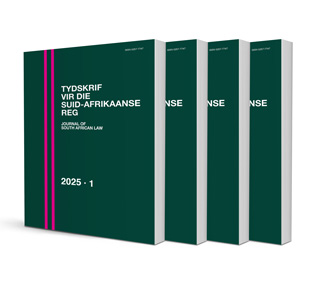Abstract
Die saak van MEC for Health, Gauteng v Solomons het sy weg gebaan deur drie hoë howe, te wete die Gauteng plaaslike afdeling van die hooggeregshof, Johannesburg, gevolg deur die volle bank van daardie afdeling en daarna die hoogste hof van appèl, sonder dat dit enige voordeel vir enige van die rolspelers, behalwe die regsverteenwoordigers, gebring het. Die rede vir die onnodige litigasie, met meegaande hoë koste, was die hardkoppige en arrogante optrede van die lid van die uitvoerende raad (LUR) van die Gautengse departement van gesondheid. Die feitelike gebeure in die drie howe, wat vol kinkels en draaie is, kan kortliks soos volg opgesom word.
Die eiseres in die hoofgeding het, namens haar minderjarige kind, ’n aksie vir skadevergoeding teen die LUR ingestel weens breinskade wat haar kind by geboorte opgedoen het as gevolg van nalatigheid van die mediese personeel betreffende die voor-geboorte prosedures. Terwyl die geding hangende was, het die LUR ’n subpoena duces tecum op Dr Regan Solomons, ’n medeprofessor aan die departement van geneeskunde en gesondheidswetenskappe aan die Universiteit van Stellenbosch, laat beteken (hierna “prof Solomons”). Prof Solomons was ’n mede-outeur van ’n artikel wat met breinskade van babas by geboorte gehandel het en die LUR het by wyse van die subpoena duces tecum gepoog om ’n baie wye reeks inligting betreffende vorige mediese sake, deskundige verslae, mediese rekords en ander mediese data van prof Solomons te bekom. Prof Solomons het geweier om aan die subpoena te voldoen, as gevolg waarvan die LUR onmiddellik ’n dringende aansoek tot die Gautengse hooggeregshof in Johannesburg gerig het waarin sy gevra het dat die hof prof Solomons moet verplig om die materiaal te oorhandig. Prof Solomons het die aansoek geopponeer op die grondslag, eerstens, dat hy nie die materiaal in sy besit het nie en, alternatiewelik, dat die inligting vertroulik is en dat hy volgens wetgewing dit slegs kan onthul as die betrokke pasiënte toestemming daartoe gee of as die hof hom gelas om dit te doen. Die LUR het steeds daarop aangedring dat prof Solomons aan die subpoena duces tecum moet voldoen, alhoewel sy dit nie betwis het dat prof Solomons nie die materiaal in sy besit gehad het nie. As gevolg van die LUR se stilswye betreffende dié feit, was daar nie ’n werklike dispuut om te beslis nie. Nietemin het beide die hof a quo en die volle hof die meriete van prof Solomons se alternatiewe verweer in oorweging geneem, vir doeleindes van ’n gepaste kostebevel. Beide howe het beslis dat die LUR jammerlik gefaal het in haar poging om die uitreiking van die subpoena duces tecum te regverdig. Die LUR was nog nie bereid om die handdoek in te gooi nie, klaarblyklik omdat die regskoste nie uit haar eie sak betaal hoef te word nie maar die belastingbetalers daarvoor moet opdok. Sy het gevolglik na die hoogste hof van appèl geappelleer. Daardie hof se uitspraak gaan met respek mank aan etlike gebreke. Die kern van die kritiek is dat dit oor die algemeen oppervlakkig is. Die feitelike agtergrond word nie duidelik uiteengesit nie en die volle hof se uitspraak word nie behoorlik ontleed nie hoewel dit gekritiseer word. Die hoogste hof van appèl het beslis dat die twee ander howe nie die meriete moes oorweeg het nie aangesien daar geen geskil voor dié twee howe was nie. Die hof het sonder om die meriete te behandel, die appèl van die hand gewys en beslis dat die verhoorhof die aansoek van die rol moes geskrap het.
Die volle hof het ’n deeglike uitspraak gelewer waarin rigtinggewende beginsels rakende die toepassing van die wetgewing wat die vertroulikheid van kommunikasie tussen dokter en pasiënt reguleer, neergelê is. Die uitspraak verdien lof en behoort leiding te bied aan ander howe, ten spyte van die hoogste hof van appèl se negatiewe kommentaar daarop. Die posisie in Suid-Afrika met betrekking tot die vertroulikheid van mededelings tussen dokter en pasiënt word hierna behandel, deur eerstens die gemeenregtelike bedeling aan die hand van regspraak te bespreek en daarna die wetgewende bedeling met verwysing na regspraak te behandel. Volgens laasgenoemde is die uitgangspunt dat sodanige kommunikasie streng vertroulik is. Daar is egter uitsonderings, naamlik onder andere, as die pasiënt toestemming gee vir die onthulling of as die hof dit gelas, of as dit in die openbare belang is.
Die posisie in Australië ten aansien van die onderwerp word daarna behandel. Op federale vlak en op staatlike vlak is daar verskillende wetgewende maatreëls wat beskerming bied aan die vertroulikheid van kommunikasie tussen dokter en pasiënt. Die wetgewende bepalings skep nie ’n eenvormige bedeling nie en is ook beperk, in die sin dat dit nét op hofverrigtinge betrekking het.
Die bespreking sluit af deur aan die hand te doen dat die Suid-Afrikaanse wetgewende bedeling die vertroulikheid van mededelings tussen dokter en pasiënt in ’n voldoende mate beskerm en dat dit dus nie nodig is nie om erkenning te gee aan ’n privilegie eo nomine, soos in die geval van ’n regspraktisyn en kliënt-verhouding waar kommunikasie deur regsprofessionele privilegie beskerm word. Daarbenewens, is daar ook geen baat te vind by die Australiese wetgewende bedeling nie. Die hoogste hof van appèl se uitspraak in die Solomons-saak gaan met respek mank aan substansie, maar dit het minstens die geleentheid gebied om ’n aktuele onderwerp te bespreek. Gelukkig het die volbank se uitspraak in die saak vergoed vir die leemtes in die hoogste hof van appèl se uitspraak.
